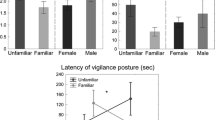Abstract
In the raccoon dog,Nyctereutes procyonoides, utilization of latrines (defecation and urination sites), and olfactory recognition and memorization of latrine feces were studied in captivity. All individuals living within a cage utilized 1 communal latrine. The continuous and communal utilization of the latrine was based on a behavioural trait to deposit their excrement on the dung pile which was already present. They were attracted not only by their own dung pile but also by that of strange conspecifics. However, raccoon dogs could olfactorily recognize and memorize both their own feces and that of strange conspecifics individually. These results indicate that, in the raccoon dog, latrines serve as a place of information exchange about conspecific individuals, and olfactory memorization of the feces adjusts their social behaviour when they acutually encounter each other.
Similar content being viewed by others
References
Bannikov, A. G. 1964 Biologie du chien viverrin en U. R. S. S.Mammalia 28(1): 1–39.
Bearder, S. K. & R. M. Randall 1978 The use of fecal marking sites by spotted hyenas and civets.Carnivore 1: 32–48.
Ewer, R. F. & C. Wemmer 1974 The behaviour in captivity of the African civet,Civettictis civetta (Schreber).Z. Tierpsychol. 34: 359–394.
Ikeda, H., K. Eguchi & Y. Ono 1979 Home range utilization of a raccoon dog,Nyctereutes procyonoides viverrinus Temminck, in a small islet in Western Kyushu.Jap. J. Ecol. 29: 35–48.
Kleiman, D. G. & J. R. Malcolm 1981 The evolution of male parental investment in mammals. In: D. J. Gubernick & P. H. Klopfer (eds.)Parental care in mammals. pp. 347–387. Plenum Press, New York.
Kruuk, H. 1978 Spatial organization and territorial behaviour of the European badger,Meles meles.J. Zool., Lond. 184: 1–19.
Macdonald, D. W. 1980 Patterns of scent marking with urine and faeces amongst carnivore communities.Symp. Zool. Soc. Lond. 45: 107–139.
Novikov, G. A. 1956 Carnivorous mammals of the fauna of the USSR. 284 pp. (Israel Program for Scientific Translations, Jerusalem, 1962)
Rasa, O. A. E. 1973 Marking behaviour and its social significance in the African dwarf mongoose,Helogale undulata rufula.Z. Tierpsychol. 32: 293–318.
Roeder, J. J. 1980 Marking behaviour and olfactory recognition in genets (Genetta genetta L., Carnivora-Viverridae).Behaviour 72: 200–210.
Seitz, A. 1955 Untersuchungen über angeborene Verhaltensweisen bei Caniden. III. Teil. Beobachtungen an Marderhunden (Nyctereutes procyonoides Gray).Z. Tierpsychol. 12: 463–489.
Yamomoto, I. & T. Hidaka Utilization of “latrines” in the raccoon dog,Nyctereutes procyonoides. Acta Zool. Fennica (in press).
Author information
Authors and Affiliations
About this article
Cite this article
Yamamoto, I. Latrine utilization and feces recognition in the raccoon dog,Nyctereutes procyonoides . J. Ethol. 2, 47–54 (1984). https://doi.org/10.1007/BF02348206
Received:
Accepted:
Issue Date:
DOI: https://doi.org/10.1007/BF02348206




